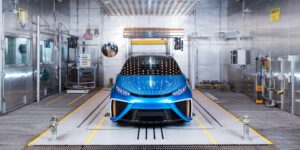
September 7, 2023
The effects of climate change grow more tangible by the day. As a result, the electric power industry is hastening efforts to reduce environmental impact. To do so, they need help to get a clearer picture of where they fall on the emissions reduction roadmap, and to better understand their opportunities for improvement. This is where harnessing artificial intelligence (AI) and data analytics can help.
To assist utility companies, IBM has created the Clean Electrification Maturity Model (CEMM) in conjunction with the American Productivity & Quality Center (APQC). Based on 14 years of development and input from electric utility experts, the CEMM provides a series of benchmarks to help utility companies measure the maturity of their clean electrification capabilities, set priorities for transformation and track their progress along the way.
The results from the first global CEMM benchmark of 90 transmission and distribution utilities paint a telling picture of the role that technology can play in this critical transformation. Companies that harness AI and data analytics can also make clean energy more viable overall by increasing their cost competitiveness over legacy energy sources.
On average, 3.3 times more of the most mature utilities prioritize research in energy balancing and trading. This research can enable more liquid markets and lower energy prices for customers. By introducing AI into the renewable energy generation, transmission and distribution processes, utilities can better predict weather patterns in advance, giving them better insights into the output of solar and wind farms.
AI: The road ahead for energy and utilities
AI can also benefit customer care, freeing up resources for innovation in other aspects of their business. The most mature utilities were more than four times more likely to utilize customer experience platforms, including AI-powered chatbots and data analytics for personalized service. The latter can also help drive efficiency by lowering end-user energy use. Informed by automated reports, customers can better understand their energy consumption and take steps to reduce their power draw during peak periods of demand.
Despite these strides, the industry still has a lot of ground to make up to realize its carbon reduction goals. According to the CEMM study, the most mature 25% of transmission and distribution utilities still only achieved the modest overall score of 2.2 out of 5 across all domains. The average maturity for all T&D utilities was at the 1.6 mark. Technological maturity has vast potential for improvement; here, the most mature segment fared only marginally better than the bottom 75%, falling into the lowest development category.
Global electricity demands continue to rise. Utility companies must take urgent action to realign their organizations’ strategies and implement intelligent, data-driven processes for change. By emulating the successes of industry leaders and adopting the latest proven AI-enabled technologies, utility companies can take a big step toward meeting their own emissions goals and reducing the impact of climate change on the planet.
Access the full report and insights on the IBM Institute for Business Value
More from Sustainability

August 24, 2023
2018 Call for Code Winner Project OWL advances its natural disaster communication network
3 min read – For disaster-prone areas, fragile connectivity remains a major problem, often going offline in critical moments. Aerospace enterprises face a similar challenge when trying to run consistent high-altitude connectivity while operating in remote locations, which can also be very expensive. This is where Project OWL comes into play: developing new technologies to help address these challenges. Formed in 2018 to compete in the inaugural Call for Code Global Challenge — which it won — Project OWL is a global team of entrepreneurs…
<!—->

August 16, 2023
IBM’s dedication to responsible computing
2 min read – In response to concerns faced by corporations about the impact of technology on our environment, IBM founded the Responsible.Computing() movement, creating a membership consortium with Dell that is managed by the Object Management Group. Customers and partners expect responsible corporate policies and practices, and they also build loyalty with employees. Responsible computing establishes a cohesive, interconnected framework across six critical domains to provide every organization the ability to educate on their responsibilities, define goals and measure their progress against these aspirations:…
<!—->

August 11, 2023
12 considerations when choosing MES software
4 min read – Manufacturing execution systems (MES) have grown in popularity across the manufacturing industry. Implementing such solutions could be the key to a new era of productivity for your organization, but implementing new and expansive IT software can be intimidating. The right time to implement an MES depends on the specific needs and circumstances of each organization, and while there is no one-size-fits-all answer, several key indicators can suggest that it might be the appropriate time. If your manufacturing processes have become…
<!—->

August 8, 2023
How to choose the best enterprise asset management software
4 min read – Large organizations are comprised of many assets that require continuous monitoring to ensure optimal productivity. One business’ assets might be thousands of miles of electrical wiring, while another’s might be manufacturing equipment or warehouses. Whatever the case, large organizations can benefit from enterprise asset management (EAM) software to manage all the physical stuff the company owns. While there are a lot of EAM products on the market, this article will help you ask the right questions to find the right…
<!—->
- SEO Powered Content & PR Distribution. Get Amplified Today.
- PlatoData.Network Vertical Generative Ai. Empower Yourself. Access Here.
- PlatoAiStream. Web3 Intelligence. Knowledge Amplified. Access Here.
- PlatoESG. Automotive / EVs, Carbon, CleanTech, Energy, Environment, Solar, Waste Management. Access Here.
- PlatoHealth. Biotech and Clinical Trials Intelligence. Access Here.
- ChartPrime. Elevate your Trading Game with ChartPrime. Access Here.
- BlockOffsets. Modernizing Environmental Offset Ownership. Access Here.
- Source: https://www.ibm.com/blog/harnessing-ai-and-data-analytics-can-make-clean-energy-more-viable/
- :has
- :is
- :where
- $UP
- 1
- 11
- 12
- 13
- 14
- 16
- 2018
- 2023
- 23
- 24
- 29
- 30
- 300
- 40
- 400
- 51
- 7
- 8
- 9
- 90
- a
- ability
- About
- According
- achieved
- across
- Action
- address
- Adopting
- advances
- Advertising
- Aerospace
- against
- ahead
- AI
- AI-powered
- All
- along
- also
- American
- amp
- an
- analytics
- and
- answer
- appropriate
- ARE
- areas
- article
- AS
- ask
- aspects
- asset
- asset management
- Assets
- assist
- At
- AUGUST
- author
- Automated
- average
- back
- balancing
- based
- BE
- Benchmark
- benchmarks
- benefit
- BEST
- Better
- Big
- Blog
- Bottom
- build
- business
- but
- by
- call
- CAN
- capabilities
- carbon
- Carbon Reduction
- card
- Cards
- care
- case
- casey
- CAT
- Category
- Center
- challenge
- challenges
- change
- chatbots
- check
- Choose
- choosing
- circumstances
- class
- clean energy
- clearer
- Climate
- Climate change
- code
- cohesive
- color
- comes
- Communication
- Companies
- company
- compete
- competitiveness
- Comprised
- computing
- Concerns
- conjunction
- Connectivity
- considerations
- consistent
- consortium
- consumption
- Container
- continue
- continuous
- Corporate
- Corporations
- Cost
- could
- created
- Creating
- critical
- CSS
- custom
- customer
- customer experience
- Customers
- data
- Data Analytics
- data-driven
- Date
- day
- dedication
- Default
- define
- definitions
- Dell
- Demand
- demands
- depends
- description
- developing
- Development
- disaster
- distribution
- do
- domains
- draw
- drive
- during
- each
- educate
- effects
- efficiency
- efforts
- Electric
- electricity
- Emissions
- employees
- enable
- energy
- Energy Consumption
- energy prices
- energy use
- engineer
- ensure
- Enter
- Enterprise
- enterprises
- Environment
- environmental
- equipment
- Era
- establishes
- Ether (ETH)
- Every
- execution
- Exit
- expansive
- expect
- expensive
- experience
- experts
- Face
- faced
- Fall
- Falling
- Farms
- Find
- First
- Floor
- follow
- fonts
- For
- formed
- Founded
- four
- Framework
- from
- full
- Full Report
- generation
- generator
- get
- Giving
- Global
- Goals
- going
- Grid
- Ground
- Group
- Grow
- grown
- harness
- Harnessing
- Have
- height
- help
- here
- How
- How To
- HTTPS
- IBM
- ICO
- ICON
- if
- image
- Impact
- implement
- implementing
- improvement
- in
- In other
- Inaugural
- Including
- increasing
- index
- Indicators
- industry
- informed
- Innovation
- input
- insights
- Institute
- Intelligent
- interconnected
- intimidating
- into
- introducing
- IT
- ITS
- jpg
- Key
- large
- latest
- leaders
- Legacy
- likely
- Liquid
- locale
- locations
- Lot
- lower
- lowering
- lowest
- Loyalty
- made
- major
- make
- manage
- managed
- management
- manager
- manufacturing
- manufacturing industry
- many
- map
- mark
- Market
- Markets
- mature
- maturity
- Maturity Model
- max-width
- measure
- meeting
- membership
- might
- min
- minutes
- Mobile
- model
- modest
- Moments
- monitoring
- more
- most
- movement
- must
- Natural
- Navigation
- Need
- needs
- network
- New
- New technologies
- no
- nothing
- object
- of
- offline
- often
- on
- ONE
- only
- operating
- opportunities
- optimal
- optimized
- or
- organization
- organizations
- Other
- our
- out
- output
- over
- overall
- owl
- own
- owns
- page
- paint
- partner
- partners
- patterns
- Peak
- periods
- Personalized
- PHP
- physical
- picture
- planet
- Platforms
- plato
- Plato Data Intelligence
- PlatoData
- Play
- plugin
- policies
- policy
- popularity
- position
- Post
- potential
- power
- practices
- Prices
- Prioritize
- Problem
- processes
- productivity
- Products
- Progress
- project
- proven
- provide
- provides
- quality
- Questions
- Reading
- realize
- reduce
- reducing
- reduction
- remains
- remote
- Renewable
- renewable energy
- report
- Reports
- require
- research
- Resources
- response
- responsibilities
- responsible
- responsible computing
- responsive
- result
- Results
- right
- Rise
- road
- roadmap
- robots
- Role
- Run
- score
- Screen
- scripts
- segment
- seo
- Series
- service
- set
- several
- similar
- site
- SIX
- small
- So
- Software
- solar
- Solutions
- Sources
- specific
- Sponsored
- start
- Step
- Steps
- Still
- strategies
- strides
- Study
- such
- suggest
- Systems
- Take
- tangible
- team
- technological
- Technologies
- Technology
- than
- that
- The
- their
- Them
- theme
- There.
- These
- they
- this
- thousands
- time
- times
- Title
- to
- top
- toward
- track
- Trading
- Transformation
- type
- understand
- urgent
- URL
- use
- utilities
- utility
- utilize
- Vast
- very
- viable
- W
- Warehouse
- was
- Way..
- Weather
- weather patterns
- were
- whatever
- when
- which
- while
- will
- wind
- wind farms
- winner
- with
- Won
- WordPress
- workers
- world
- written
- years
- you
- young
- Your
- zephyrnet












